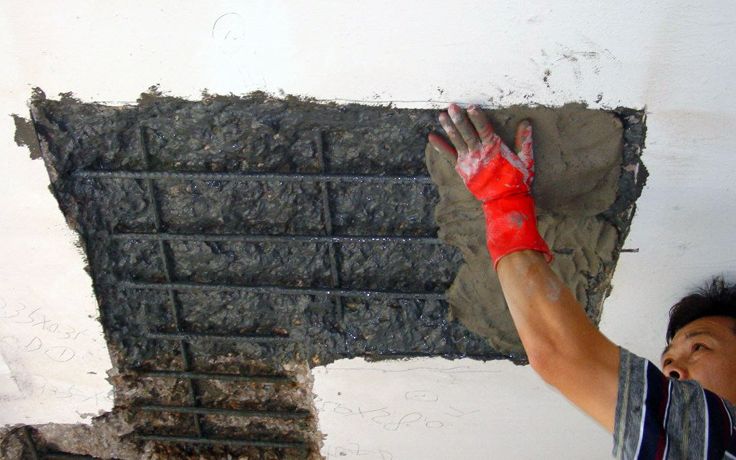£7.75 delivery on orders excluding certain products & postcodes *
Ronacrete RonaBond HB40
RonaBond HB40 mortar is used for repairing concrete on vertical and overhead surfaces where ease of application is as important as strength.
Best Uses
Ronacrete RonaBond HB40 can be applied in relatively thick section to walls and soffits and, depending on the nature of the repair, in layers up to 75mm depending on size and orientation.
- Suitable for high build repairs to 75mm
- Provides ease of application
- Pre-packed for control and convenience
- Waterproof
- Frost proof
- Smooth surface finish prior to application of protective / decorative coating
- Provides high strength, monolithically bonded mortar
- Ideal for structural concrete repair, dubbing out
- Excellent for thick section soffit work
Ronacrete RonaBond HB40 is supplied pre-packed requiring only the addition of water.
Application
Preparation of concrete and steel
All concrete identified for removal must be broken out to ensure that repair materials are applied to a sound and stable substrate and that the minimum mortar thickness can be applied throughout. Repair edges must be saw cut at an angle of 90 degrees to the plane of the concrete, to avoid feather edging.
Reinforcing steel in the repair area must be exposed to its full circumference, until uncorroded steel is visible, to a sufficient depth for adequate cleaning of the bar, loose rust and scale must be removed. Cover to reinforcement must be ≥15mm to ensure adequate protection of steel and prevent reflective cracking. Corroded steel must be replaced where necessary. All removal of concrete and steel must be carried out in accordance with the specification.
When repairing chloride contaminated concrete the method used to prepare and prime surfaces may differ and our Technical Department should be consulted. All surfaces must be cleaned to remove loose dust, debris and surface contamination which may prevent adhesion of the repair mortar to concrete and steel. Concrete must be clean and prepared with a scabbler or needle gun.
Wetting and priming
Following preparation of concrete and steel, thoroughly wet all concrete surfaces to be repaired with clean water to satisfy concrete porosity. Remove free water immediately before priming. Brush apply Ronacrete Standard Primer to the steel and allow to become tacky, not dry. When the priming coat on steel is tacky, brush a single coat of the same primer on to the damp concrete and a second coat on to the steel. Ensure that the first priming coat applied to the steel is not removed during the application of the second coat, or scatter kiln-dried sand into the wet first coat and apply the second coat to the dry and keyed first coat.
Mixing
RonaBond HB40 Rapid must be mixed mechanically in a forced action mixer (e.g. Creteangle pan mixer) or using a high power slow speed drill (typically 500 rpm) with a paddle attachment, MR 4 or similar (do not use a free fall mixer).
Pour the dry powder into a mixing vessel containing ≥ 3 litres (but not more than 3.2 litres) of clean water. Mix for approximately 3 minutes to produce an even consistency. Note that the mix will stiffen during transit to the repair position.
Use complete packs to ensure consistency, uniform dispersion of pack contents and accuracy of powder:water ratio. To avoid a false set in warm working conditions store materials in the shade and use cool water.
Application
The mortar must be applied to the wet or tacky primer before the primer dries. If the primer dries it must be thoroughly scarified and reapplied. Apply the mortar to reform the original profile of the concrete and cover reinforcing steel. Ensure that the mortar is fully compacted, paying particular attention to avoidance of voids around reinforcement. Layer thickness will vary according to the shape and size of the repair, the texture of the substrate and application technique. Application techniques include hand packing the mortar on to the surface.
When multiple layer application is required, each intermediate layer must be combed and allowed to harden before application of Ronacrete Standard Primer and a further layer of mortar. The repair must be finished with a steel or wood float, and may be dry sponge finished if required. If applying a protective or decorative coating such a RonaBond Crack Bridging Anti Carbonation Coating WB, RonaBond Anti-Carbonation Coating WB or RonaBond Masonry Paint WB, leaving the final layer with a sponge finish will aid adhesion.
Curing
Cure with Ronacrete Curing Membrane or tight fitting polythene as soon as possible and as quickly as is practical to prevent rapid early moisture loss from the mortar surface and minimise the risk of resultant plastic cracking. Curing is more important when working in direct sunlight and/ or in a drying breeze or wind. Note that maximum application depth per layer is reduced and typical maximum layer thickness in larger repairs is 50mm vertically and 30mm overhead.
| Components: | Single Pack |
| Type: | Pre-Packed Mortar |
| Min / max thickness: | 6 / 75mm |
| Compressive strength at 28 days: | 35N/mm2 |
| Tensile strength at 28 days: | 2.9N/mm2 |
| Flexural strength at 28 days: | 7.1N/mm2 |
| Density: | 1550 |
| Min / max application temperature: | +5 / 25C |
| Water addition per pack: | 3 - 3.2 Litres |
| Yield per pack: | 13 |
| Theoretical Coverage: | 1m2 at 13mm |
| Packs required per m³: | 77 |
| Shelf Life: | Store unopened between 10°C and 25°C in dry warehouse conditions and out of direct sunlight. In these conditions shelf life is approximately 6 months. |
| Packaging: | Available in 18 Kg |
